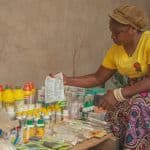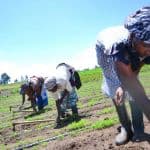Sustainable Connectivity: How Biofuels Can Boost Mobile Access, Support Small Farmers – And Fight Climate Change
In rural villages across communities in Africa and Asia, families stay connected with distant loved ones, and benefit from reduced information and transaction costs, by using a mobile phone — but only during the day. That’s because the mobile cellular towers that serve many small remote communities usually rely either on diesel power, which is not always available, or electricity from solar panels, which is dependent on clear, sunny skies.
In over a million rural communities across the developing world, mobile cellular base station towers provide voice and data network coverage despite poor electrical grid infrastructure. These towers exist in what telecommunications industry analysts describe as “no grid” or “bad grid” situations – places where electrical power is either unavailable, or intermittent and unreliable. In many of these locations, mobile network operators, or the tower companies that lease their equipment to mobile operators, use diesel generators or solar power to substitute for the lack electrical grid power. As a result, the cellular industry has been very successful in ensuring that mobile network coverage extends even into rural and remote areas that lack other basic infrastructure, such as roads, electricity and running water. As such, over 95 percent of the world’s population now live in areas where at least basic mobile service is available.
The Downside to Greater Mobile Access
However, this extension of service comes at an economic and ecological cost. The association for mobile network operators (GSMA) estimates the cost of diesel consumption to mobile operators for powering off-grid and bad-grid towers will be US $19 billion a year by 2020, based on the forecasted demand for over 150 million barrels of diesel. This diesel consumption will contribute to approximately 45 million tons of carbon dioxide being released per year, just from operating cell towers with insufficient power grid options.
Fortunately, the mobile industry has been actively seeking ways to substitute expensive, dirty diesel generation with renewable energy solutions. Advances in radio technology are reducing the power needs of cellular base stations, allowing for solar cells to adequately supply sufficient energy. Lower power radios are emerging that are fit to serve small communities, and engineers are also exploring how to harness other renewable energies, such as wind, in some areas. But even with these advances, the same challenge remains: How can these towers maintain electrical supply through the evening hours, when poor weather obscures sunlight, or during periods of low wind?
A Sustainable Solution
Batteries to capture and store power remain expensive, and they add to the up-front capital investment required for off-grid towers. They also entail increased operating costs for security and insurance. But another solution is emerging that mobile operators in rural sub-Saharan Africa are starting to notice: bioenergy. Farmers are planting trees for fertilizer, fodder and fuelwood into their crop fields, producing the biomass used for electrical power generation, while also directly increasing crop yields and providing enhanced, high-quality livestock fodder. These trees improve vegetative soil cover year-round, and increase soil fertility. They also buffer crop production from the droughts and higher temperatures now occurring due to climate change. And they store significant quantities of carbon in the soil, while enhancing biodiversity.
Bioenergy is already providing substantial electrical production in places like Sri Lanka. There are now eight tree-based power plants built and operated by private sector companies in operation in the country, and 10 or more plants are under construction or in the feasibility stage. These systems are based on the cultivation of nitrogen-fixing trees that capture nitrogen for use as fertilizer by smallholder farmers in their crop fields, and the sale of the wood to the power plants. Their power generation ranges from small-scale electrical production for local use (producing 4 KW to 9 KW), to large plants capable of producing 5 MW to 10 MW of electricity.
These bioenergy solutions have technical and social benefits over the conventional renewable energy sources now used, such as solar energy. Biomass energy can be used to power the cell towers in order to enhance a stable baseload. It can ensure a continuous supply of power that can be increased or decreased when needed, avoiding involuntary power fluctuations. And beyond addressing the challenge of electrification for rural and remote cellular base stations, these systems also significantly contribute to local communities in ways that are not evident in other forms of renewable energy systems.
Multiple Benefits to Local Communities
To take one example, the production of bioenergy involves and engages the local community. Instead of importing expensive diesel fuel from urban centers, or high-tech equipment from foreign countries, the bioenergy needed to fuel these power plants comes from the smallholder farmers in the community themselves. The wood is produced by smallholder farmers in their farm fields, alongside their maize and other crops. Across Africa and South Asia, hundreds of thousands of farm families are already familiar with woody shrubs like Gliricidia (a particularly efficient and effective fuel wood), and they have already incorporated them into their farming systems to increase their food production. The potential for selling the surplus wood to local producers of electrical power would provide them with an incentive to expand the cultivation of these valued agroforestry systems.
As a related benefit, the cropping system that best provides smallholder farmers with a portfolio approach to income and nutritional production involves the integrated cultivation of food crops with shrubs and trees. Across Africa, trees are already widely integrated into agricultural systems, and they are increasingly the basis for sustainably boosting maize production in countries like Malawi, Zambia and Kenya. Their cultivation in farm fields dramatically increases crop production, providing smallholders with greater food security, income and better nutrition. In Eastern Zambia for instance, through a major extension program implemented by COMACO, over 80,000 smallholder farm families have recently planted a total of 41 million Gliricidia shrubs, on over 27,000 hectares of land.
The Impact on Climate Change
On the 200 million hectares of croplands in Africa alone, the promotion of this solution on a much more expansive scale could also address the global community’s goal of increasing carbon capture on a massive scale, in order to mitigate against rising global temperatures in the fight against climate change. As the recent IPCC report details, curbing the release of carbon dioxide into the atmosphere is not enough to mitigate against rising global temperatures. The global community must also accelerate carbon capture to even have a shot at limiting global temperature rises to 1.5 degrees Celsius by 2050.
But the report presents a false dichotomy in the path towards this carbon capture. There is actually no need to choose between utilizing arable land for food production versus using it in carbon capture through tree production. Agroforestry techniques, which the World Agroforestry Center has been pioneering for the last three decades, provide proven methods of crop production that incorporate food crops with shrubs and trees – increasing both crop yields and carbon capture in the soil and vegetation. These methods can also supply vast quantities of wood fuel from the crop fields to power electricity generation. This is a triple win – a trade-in not a trade-off.
Mobilizing Renewable Biomass for Telecommunications
Mobile base station operators in Africa are already exploring how to convert from diesel to biomass renewables and build renewable-only cellular base stations in rural communities.
This is the sort of proactive, forward-looking engagement by the telecommunications industry that will be required eventually by all sectors, if we as a global community hope to truly address climate change.
The next step in developing these solutions is the implementation of robust pre-feasibility and feasibility studies for integrated food-energy systems that will provide a renewable source of power for rural base stations, while increasing food production and supporting global carbon capture. While such integrated food-energy systems have been successfully commercialized in Sri Lanka and India, with a number of power plants operating, context-specific research is needed to localize and deploy these solutions in Africa and throughout the tropics, and to incorporate them into mobile cellular network infrastructure.
For instance, in the Philippines, India and other countries across Asia, where rice production feeds billions of people, rice cultivation by-products such rice straw and rice husk are also being used for bioenergy purposes: Further research is necessary to apply these solutions to power production for last-mile Internet connectivity infrastructure. These feasibility studies will determine how best to apply these techniques to support commercial biomass project development in order to provide greater food security, income and employment, along with power generation for rural communities in eastern and southern Africa and beyond.
We urge you to join us, the Evergreening Global Alliance, in exploring and deploying these systems, to tackle food insecurity, poor grid infrastructure and global climate change. It’s an evergreen energy triple win.
John Garrity is a technical advisor on internet connectivity at UNDP Philippines.
Dennis Garrity is a systems agronomist and research leader based in Nairobi.
James Daniel is a spatial analyst and renewable energy consultant based in Nairobi.
Photo courtesy of Malcolm Manners.
Homepage photo courtesy of jbdodane.
- Categories
- Agriculture, Energy, Environment, Technology, Telecommunications



